79 F. high temperature Friday in the Twin Cities.
80 F. average high on June 19.
74 F. high on June 19, 2014.
June 19, 1955: Hailstones the size of hen’s eggs were dropped in Roseau County.
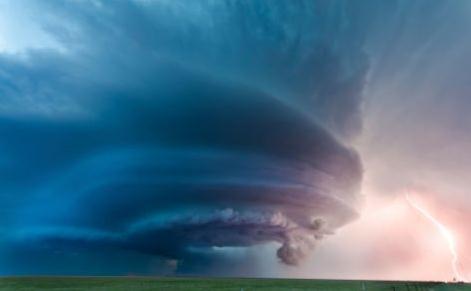
Old Husbands’ Tales
There’s a lot of bad, outdated information out there – why should weather be any different?
A few Oldies but Moldies: “There’s a local tornado alley in the metro that runs from Lake Minnetonka to Fridley!” Wrong. For the past 40-50 years you could make a case, but a longer, historical examination confirms no “favored communities” for metro-scale twisters.
“The southwest corner of your basement is the safest place to ride out a tornado.” Nope. New studies confirm the safest spot from falling debris is your basement, under the stairs.
“Open up windows to relieve air pressure before a tornado strikes!” Bad idea. New research shows that opening a few windows won’t make a difference, structurally. It’s a wild goose chase.
“A greenish-yellow sky before a tornado?” True. White light filtered through large hailstones can give the sky before a tornado a downright evil appearance.
T-storms this morning give way to some sticky afternoon sun. Expect a streak of low 80s next week, but no stinking-hot weather is brewing between now and the 4th of July.
For the record July is the hottest month of the year and I see signs of heat building in 2-3 weeks. Enjoy the weather honeymoon. No complaints!
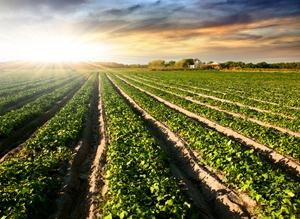
Crops In Great Shape. Dr. Mark Seeley takes a look at soil moisture, which is now in very good condition across most of Minnesota. The drought is over. Here’s an excerpt from this week’s edition of Minnesota WeatherTalk: “Early planting and nearly seasonal temperatures with continued adequate rainfall across the state have promoted very good prospects for Minnesota crops this year. With 77 percent of the MN corn crop in good to excellent condition and 74 percent of the soybean crop in good to excellent condition, crop producers and consultants are pleased with the growing season so far. Soil moisture storage is adequate in most areas of the state. Farmers are trying to catch up on weed control with cultivation or use of post-emergence herbicides. Some areas of the state have already received over 4 inches of rainfall this month, including 5.68″ at Melrose, 4.45″ at Sartell, 4.35″ at Waseca, 4.28″ at Owatonna, 4.06″ at Austin, 4.47″ at Caledonia, 4.28″ at Zumbrota, and 5.11″ at Theilman…”
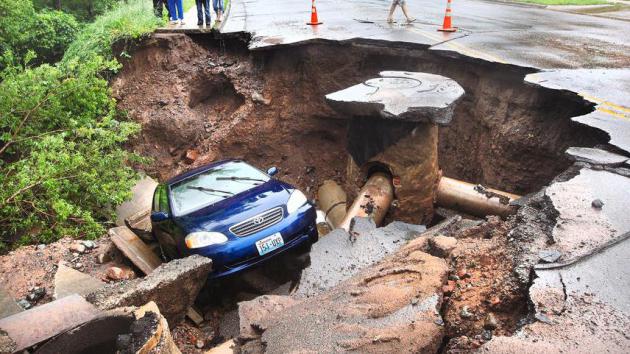
The Flood of 2012, Three Years Later. The Duluth News Tribune has a good summary of the historic flood that struck Duluth in late June, 2012, and recovery efforts since the deluge. Here’s the intro: “Three years ago today, June 19, storm clouds billowed into the skies above the Northland and rain started to fall. Over and over and over, well into the next day, downpours soaked Duluth, Superior, Carlton County, the North Shore and surrounding areas. Streets turned into streams, and streams turned into torrents. Homes and businesses were ruined, and lives of many Northland residents were upended — but, fortunately, not lost…”
Photo credit above: “Onlookers take in the scene of a car that fell into a huge sinkhole on Skyline Parkway at 9th Avenue East in Duluth after the June 2012 flood. Rainwaters undercut the ground beneath to create the weak spot in the pavement. The car’s owners were from Seattle and came to Duluth to run Grandma’s Marathon and visit family.” (File photo / Bob King).
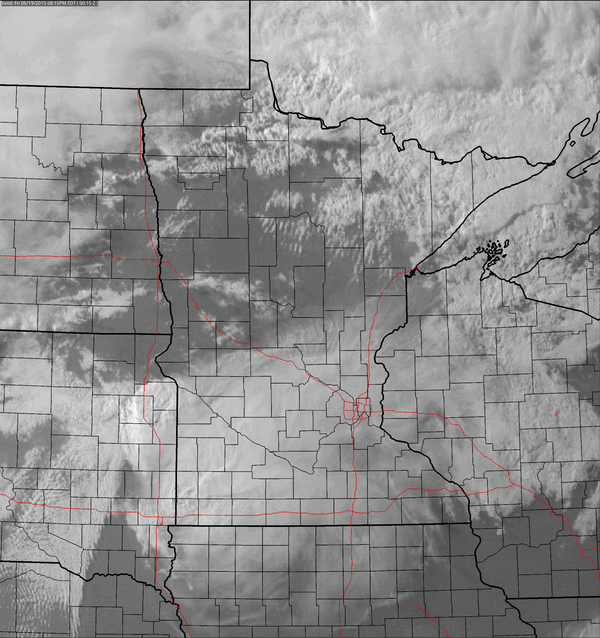
Becoming Volatile. Yesterday evening’s high-resolution 1 KM visible cloud loop, courtesy of NOAA and AerisWeather, shows the thunderheads that bubbled up over southwestern Minnesota responsible for up to 1.75″ diameter hail – firing up along the leading edge of a steamy hot front.
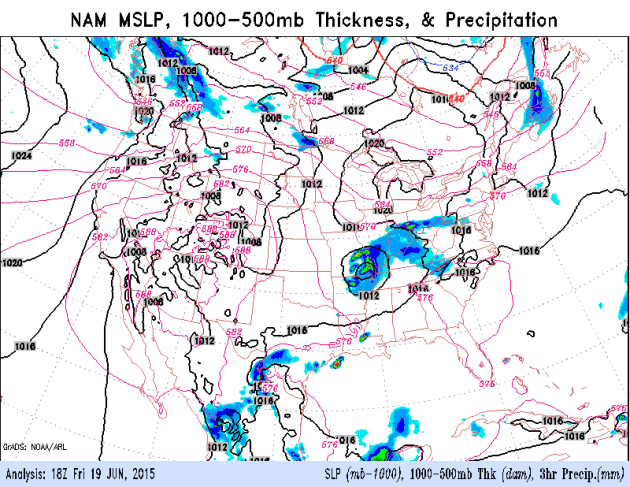
NAM Guidance. Watch the remains of “Bill” track from south of St. Louis right up the Ohio River Valley, spiking thunderstorms from Washington D.C. to Philadelphia by Sunday, where flash flooding can’t be ruled out. Meanwhile T-storms push east of Minnesota by midday, but a few spotty cells may pop up by evening, again Sunday. It’s that time of year when it’s difficult to promise a completely-dry day. Loop: NOAA.
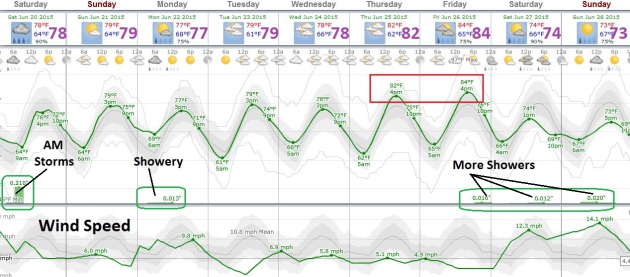
Just About Average. Thhe average high now is approaching 80F and temperatures vary a few degrees either side of average into late June; not too hot, not too cold. Showers linger Monday before a temporary dry spell Tuesday and Wednesday; another surge of attempted summer heat by the end of next week. But nothing whine-worthy, not yet. MSP meteogram: Weatherspark.
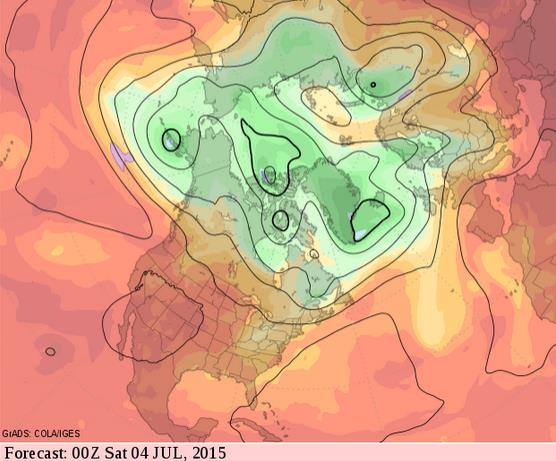
Slow Warming Trend Early July? The GFS 500 mb predicted winds, valid the evening of July 3, shows the jet stream (finally) lifting northward into Canada, allowing warmer air to expand into the Upper Midwest. June was temperature – I have a feeling July will be considerably hotter and more uncomfortable, even though the axis of heat will probably set up from California to Missouri.
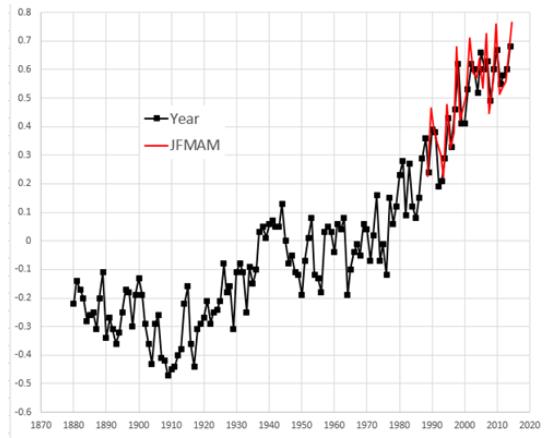
This Year Is Headed For The Hottest On Record, By A Longshot. Here’s the intro to an update at Bloomberg Business: “We broke the record. Again. Last month was the hottest May on record, and the past five months were the warmest start to a year on record, according to new data released by the National Oceanic and Atmospheric Administration. It’s a continuation of trends that made 2014 the most blistering year for the surface of the planet, in records going back to 1880…”
Graph credit above: GISS temperature departure from normal in C (red line is January through May temperature departures only). Andy Skuce, Skeptical Science.
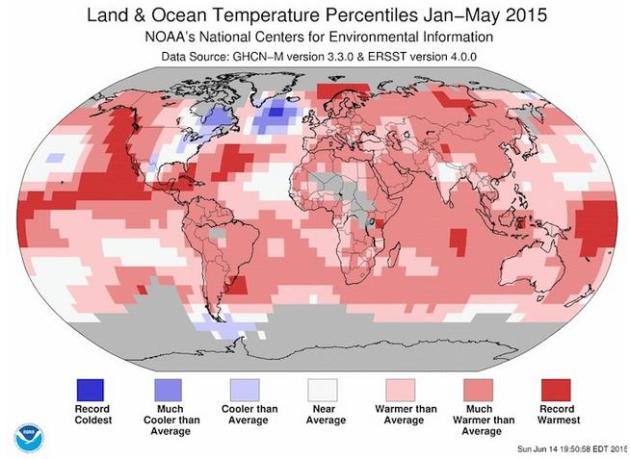
May Continues Trend of Record Hot 2015. Following up on the story above, Climate Central puts the monthly temperature departures into perspective: “…What is particularly notable about this year’s records is that how much they are beating the previous ones by, Jessica Blunden, a climate scientist with ERT, Inc., at NOAA’s National Center for Environmental Information, said in an email. The growing El Niño in the Pacific Ocean is playing a role in driving that record heat, as the climate phenomenon, most notably characterized by warmer-than-average tropical ocean waters, tends to boost global temperatures. “I wouldn’t be at all surprised if the margin of breaking records for the year-to-date continues to grow, especially if El Niño becomes as strong as some experts are predicting,” Blunden said...”
Image credit above: “Map that shows how temperatures around the globe varied from average during the period from January through May 2015.” Credit: NOAA.
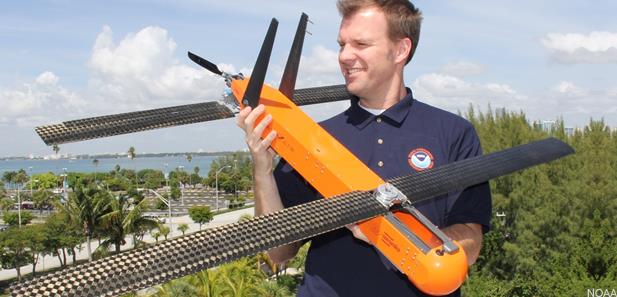
NOAA Drones Drop In On Hurricanes. GCN has the story – I need a few of these to patrol the neighborhood, come to think of it. Here’s the intro: “Just in time for this year’s hurricane season, the National Oceanic and Atmospheric Administration will be upgrading its Coyote drones for storm research and climate data collection. Raytheon will deliver three unmanned aerial systems with improved communications and integrated metorologic sensors for storm research. The Coyote unmanned aircraft, at only three feet long and between 12 and 14 pounds, can carry either electro-optical or infrared cameras and data transmitter payloads. They are capable of speeds between 60 and 85 knots and a ceiling of 20,000 feet...” (Image credit: NOAA).
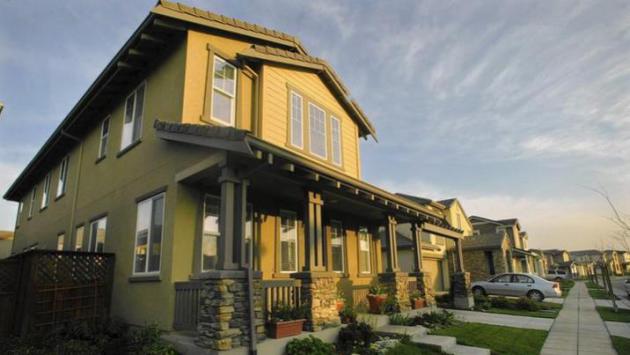
Master Planned (California) Community At Risk Of Losing All Water Within Days. What happens when a city runs out of water? At the rate we’re going it’s inevitable, and California may be the spot. Here’s the intro to a story at The Los Angeles Times: “When the state last week took the rare step of curtailing the water rights of more than 100 irrigation districts and growers, it appeared that agricultural areas would be the hardest hit. But now, an upscale master-planned community of 15,000 residents in San Joaquin County is facing the loss of all water supplies within days — prompting a frantic search for new sources…”
Photo credit above: “The master-planned community Mountain House is at risk of losing its water supply. About 160 local farmers are also affected by the curtailment order.” (Robert Durell / Los Angeles Times).

Drought Emergency. As of this week over 98% of California is in drought; 46.73% of the state in exceptional drought, the most serious drought designation. Will El Nino spark torrential rains by late autumn and winter? It’s possible, but by no means a sure thing.
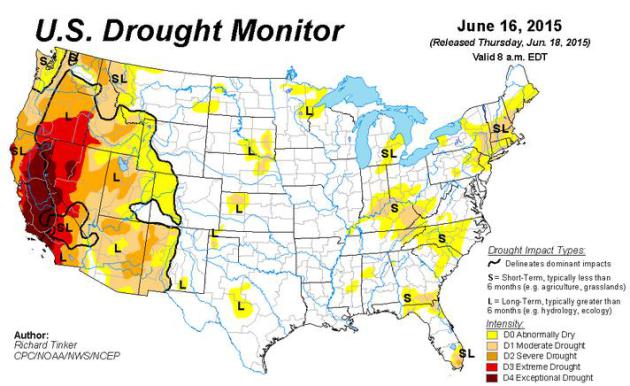
Concentrated Drought. The recent (monsoon) rains east of the Rockies have virtually erased drought for most of the United States; still a few pockets of dry weather from the Carolinas into the Florida Panhandle, but crop moisture is in good shape (with the exception of Texas and Oklahoma where there is still standing water from recent floods tied to extratropical storm “Bill”). The latest U.S. Drought Monitor is here.
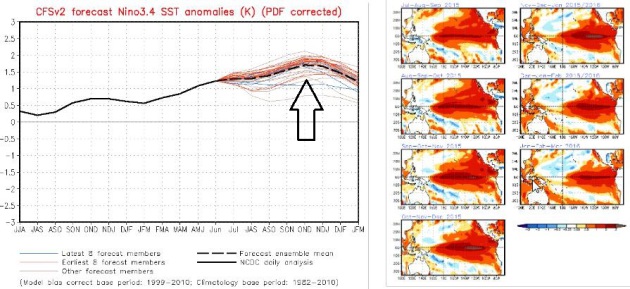
85% Chance El Nino Lingers Into Next Winter. The warm phase of ENSO in the Pacific is forecast to peak at the end of 2015 or beginning of 2016. According to NOAA there is now a 90% chance of El Nino into the autumn months; an 85% probability this warm cycle will linger into next winter. That could mean more rain for California (although this is far from a certainty – every El Nino is different) and it sways the odds of a milder winter slightly in our favor. Graphics above: NOAA.
* More details on El Nino below, courtesy of IRI, the International Research Institute for Climate and Society at Columbia University:
- El Niño and La Niña events tend to develop during the period Apr-Jun and they
- Tend to reach their maximum strength during Dec-Feb
- Typically persist for 9-12 months, though occasionally persisting for up to 2 years
- Typically recur every 2 to 7 years
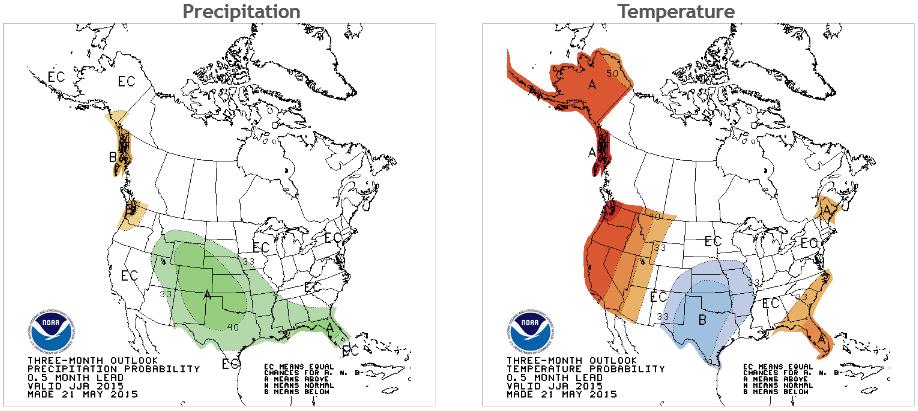
An Average Summer? Oh to be average again, not flip-flopping back and forth between drought and flood. Based on a strengthening El Nino NOAA CPC is predicting much wetter than normal conditions into August from the central Rockies into the Plains and much of the southern USA, the result of a stronger, El Nino-spiked southern branch of the jet stream. Temperatures are forecast to be cooler into August over the southern Plains, but warmer for the southeast, much warmer for the west coast and Alaska.

Who Owns Your Face? Weak Laws Give Power to Facebook. They’re putting the FACE into Facebook! The privacy challenges get more and more interesting with time. Yes, tech (and social media specifically) is a double-edge sword. Here’s the intro to a story at Fortune: “In a fateful moment for privacy, Facebook’s “Moments” uses facial recognition to expose where people went and who they were with. What a bad week for privacy. Consumer watchdogs gave up on government talks over facial recognition software after industry groups appeared to reject even basic restrictions on face-scanning. Meanwhile, Facebook rolled out a new service called “Moments” that expands the use of the company’s powerful “faceprint” technology...” (Image: FourTwoNine).
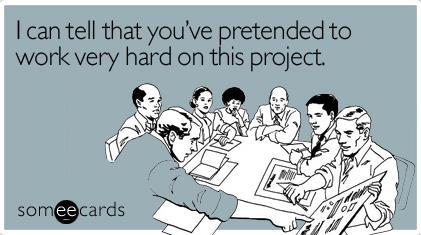
Where In The World You’re Most Likely To Be Working Too Much – Or Napping. The concept of a 50-hour work week is foreign to most Russians, but Turkey? Pretty much business as usual. Here’s an excerpt from Quartz: “…There’s huge variation in work and leisure culture around the world, often as the result of legally prescribed or enabled policies. Depending on where you are, working 50-plus hours a week might make you a huge outlier, or comparatively normal, according to the OECD’s updated Better Life Index, published last week…”

The Next Apple Watch Might Actually Be Cool. Always wait for version 2.0. Facetiming on your wrist? Not sure I’d use that Dick Tracy feature, but you never know. Here’s an excerpt from Huffington Post: “…Mark Gurman at 9to5Mac reported Thursday that Apple will release an “Apple Watch 2” next year. Hopefully no one expected their $17,000 “Apple Watch Edition” to last forever. The next version of the Apple Watch will supposedly include a video camera, which would allow people to make Facetime calls from their wrist. Try holding your arm up to your face for more than 30 seconds to see if you’d be into that...”

Clear Victory: A Deep Dive Into The World’s Most Prestigious Water-Tasting Competition. BuzzFeed has the honors; here’s the set-up to this curious story: “For 25 years, the self-proclaimed “Oscars of water” have been held in the tiny West Virginia town of Berkeley Springs. At a pivotal moment when the bottled water industry is booming but the national narrative is all about drought and environmental ruin, the stakes for perfecting the taste of nothingness have never been higher...”
Animation credit: Jon Premosch / BuzzFeed News.
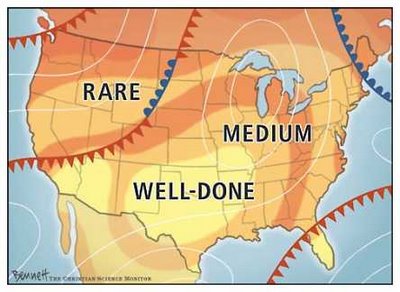

TODAY: Morning T-storms, some PM sun. Winds: W 10. High: 81
SATURDAY NIGHT: Partly cloudy and humid. Low: 66
SUNDAY: Sunnier, drier, nicer day of the weekend. Winds: NW 5-10. High: 83
MONDAY: Another round of showers and T-storms. Wake-up: 67. High: 79
TUESDAY: Fleeting sunshine. Quick – mow the lawn! Wake-up: 61. High: 77
WEDNESDAY: Steamy, T-storms southern counties. Wake-up: 59. High: 81
THURSDAY: Edge of stickiness. Spotty T-storms. Wake-up: 66. High: 82
FRIDAY: Sunny start, PM storms. Wake-up: 62. High: 79
* Shelf cloud photo credit: A.J. Lane.
Climate Stories…
“You cannot access wisdom by the megabyte. Wisdom is concerned with how we relate to people, to the world, and to God.” – Edmund P. Clowney
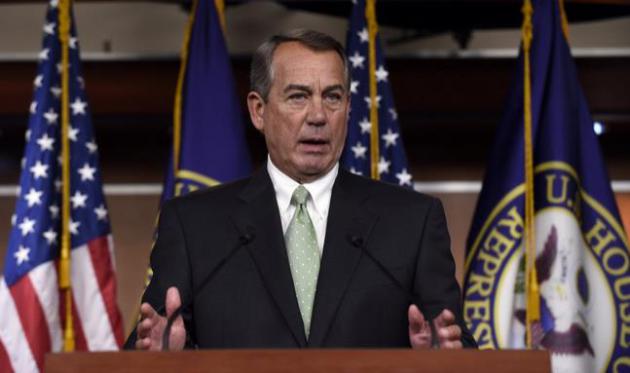
A Test of Faith: Pope Francis Puts 2016 GOP Hopefuls On The Defensive. The Washington Post reports on the created by the latest encyclical on the environment and climate change, and whether Catholic GOP presidential contenders will pay attention. Here’s a clip: “…Until recently, Democrats usually were the ones to feel the most heat. But now it is the turn of Republicans, thanks to Pope Francis, the charismatic and activist pontiff who is set to visit the United States in September. The pope’s 192-page call to action Thursday, which blames the burning of fossil fuels and human activity for climate change, is the latest example of how Francis has become part of the political debate in a season in which no fewer than five Catholics may seek the Republican presidential nomination…”
Photo credit above: “In this May 21, 2015 file photo, House Speaker John Boehner of Ohio speaks during a news conference on Capitol Hill in Washington. Pope Francis’ call for dramatic action on climate change drew a round of shrugs from congressional Republicans on Thursday, while many of the party’s presidential candidates ignored it entirely. Boehner, a Catholic who invited the pontiff to address Congress later this year, said the pope is not afraid to challenge thinking on various issues. “I respect his right to speak out on these important issues,” Boehner said, but he demurred when asked whether Francis’ views, made public in an encyclical released Thursday, might spur legislative action by the Republicans who run Congress.” (AP Photo/Susan Walsh, File).
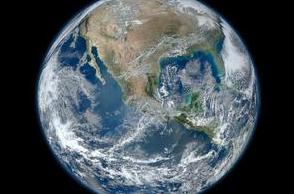
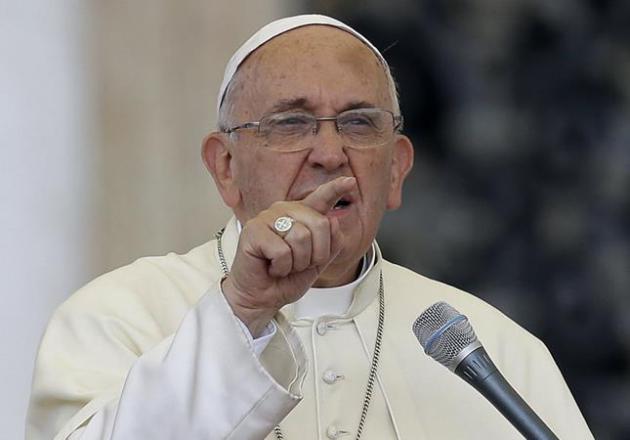
Pope Francis, in Sweeping Encyclical, Calls for Swift Action on Climate Change. The New York Times has a good summary of Thursday’s announcement from The Vatican; here’s the intro: “Pope Francis on Thursday called for a radical transformation of politics, economics and individual lifestyles to confront environmental degradation and climate change, as his much-awaited papal encyclical blended a biting critique of consumerism and irresponsible development with a plea for swift and unified global action.The vision that Francis outlined in the 184-page encyclical is sweeping in ambition and scope: He described a relentless exploitation and destruction of the environment, for which he blamed apathy, the reckless pursuit of profits, excessive faith in technology and political shortsightedness. The most vulnerable victims are the world’s poorest people, he declared, who are being dislocated and disregarded…”
Photo credit above: AP Photo/Gregorio Borgia.
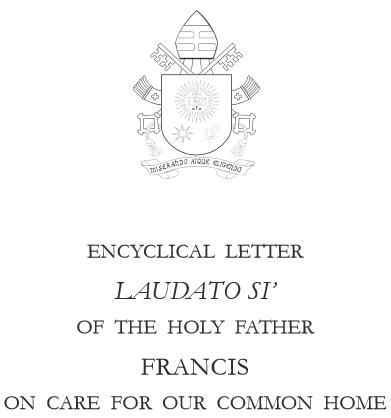
Encyclical Letter: “Laudato Si” Pope Francis is correct: climate change is a scientific challenge, an economic challenge, and ultimately a spiritual and moral challenge. If you have the time and interest read Pope Francis’s Encyclical for yourself; no media spin or interpretation. The 184 page PDF is here.
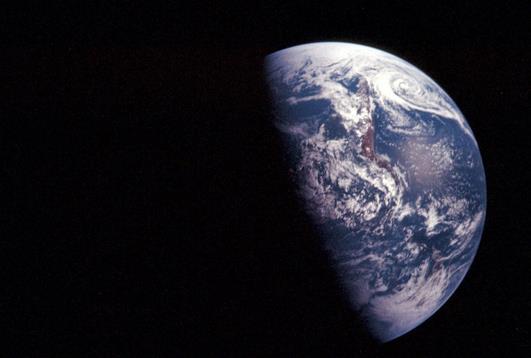
Key Quotes From Pope Francis’ Encyclical Letter. The excerpts below are courtesy of Rev. Mitch Hescox at EEN, the Evangelical Environmental Network. Full disclosure: I’m on their Board of Directors:
“The destruction of the human environment is extremely serious, not only because God has entrusted the world to us, men and women, but because human life is itself a gift, which must be defended from various points of debasement.”
“Outside the Catholic Church, other Churches and Christian communities- and other religions as well- have expressed deep concern and offered valuable reflections on issues which all of us find disturbing.”
“He [St. Francis] shows us just how inseparable the bond is between concern for nature, justice for the poor, commitment to society, and interior peace.”
“The world is a joyful mystery to be contemplated with gladness and praise.”
“..to become painfully aware, to dare to turn what is happening to the world into our own personal suffering and thus to discover what each of us can do about it.”
“…the climate is a common good.”
“It [climate change] represents one of the principal challenges facing humanity in our day.”
“The warming caused by huge consumption of the world, especially Africa, where a rise in temperature, together with drought, has proved devastating to farmers.”
“As the United States Bishops have said, greater attention must be given to ‘the needs of the poor, the weak, and the vulnerable in a debate often dominated by powerful
“Still less is there room for the globalization of indifference.”
“We still lack the culture needed to confront this crisis.”
“Many people will deny doing anything wrong because distractions dull our consciousness of just how limited and finite our world really is.”
“For all of our limitations, gestures of generosity, solidarity, and care cannot but well up within us, since we were made for love.”
“This is the way human beings contrive to feed their self-destructive vices: trying not to see them, trying not to acknowledge them, delaying the important decision, and pretending that nothing will happen.”
“Rather, all creatures are moving forward with us and through us towards a common point of arrival, which is God, in that transcendent fullness where the Risen Christ embraces and illuminates all things.”
“Jesus lived in full harmony with creation and others were amazed: What kind of man is this? Even the winds and the waves obey him! (Mt 8:27)”
“A certain way of understanding human life and activity has gone awry, to the serious detriment of the world around us.”
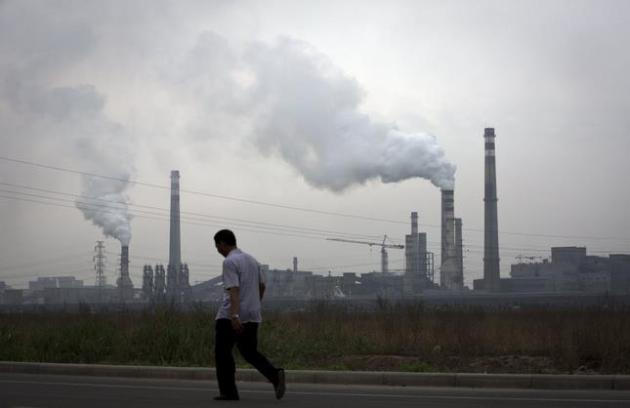
Pope Urges “Broad, Cultural Revolution” To Save Planet, Fix “Perverse” Economy That Harms Poor. The rich can build higher walls, move to higher ground, they will be able to “adapt”. The poor? Not so much. Those with the least are the first to be impacted by rising seas, more extreme storms and more intense heat and drought. Here’s a slightly different perspective from The Star Tribune: ” In a sweeping environmental manifesto aimed at spurring concrete action, Pope Francis called Thursday for a bold cultural revolution to correct what he described as a “structurally perverse” economic system where the rich exploit the poor, turning Earth into an “immense pile of filth.” Francis framed climate change as an urgent moral issue to address in his eagerly anticipated encyclical, blaming global warming on an unfair, fossil fuel-based industrial model that harms the poor most…”
File photo credit above: AP Photo/Andy Wong.

